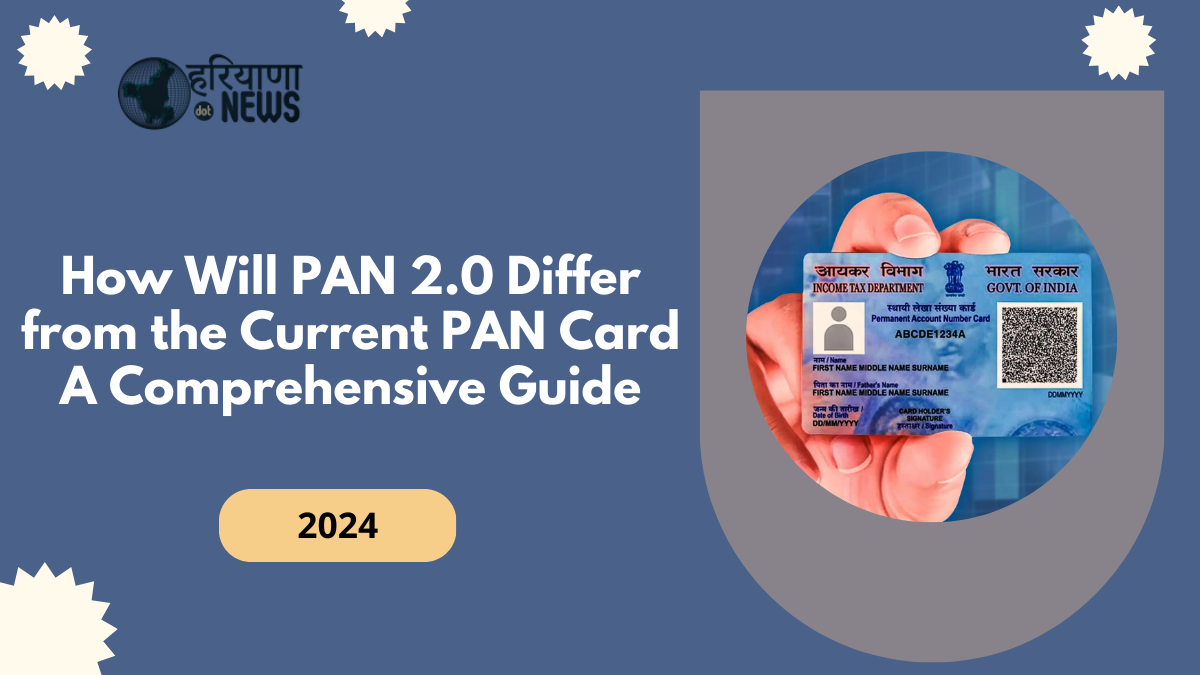The Government of India is set to introduce PAN 2.0, a significant upgrade to the existing Permanent Account Number (PAN) system. This modernization effort aligns with the Digital India initiative, aiming to improve the efficiency, security, and accessibility of the PAN system while integrating it into a broader digital ecosystem. Below is a detailed breakdown of the new system, its features, and its expected impact.
Government’s Vision Behind PAN 2.0
The announcement of PAN 2.0 by Union Minister Ashwini Vaishnaw signifies a critical step toward streamlining financial systems in India. Approved by the Cabinet Committee on Economic Affairs, this project aims to position the PAN as a universal business identifier, facilitating seamless interactions between businesses and government agencies. This initiative is part of the government’s ongoing efforts to modernize India’s financial and bureaucratic systems under the Digital India umbrella.
Key objectives of the PAN 2.0 project include:
- Enhancing the technological backbone of the PAN system.
- Making the PAN card a universal identifier for businesses.
- Improving the user experience with faster and more efficient services.
- Strengthening security to counter evolving threats.
- Promoting environmental sustainability through a paperless approach.
Major Changes and Features of PAN 2.0
1. Historical Context and Technological Leap
The PAN system, first introduced in 1972, has long served as a cornerstone of India’s taxation framework. Initially designed to act as a taxpayer identification tool, it has evolved over decades. PAN 2.0 represents the most significant upgrade yet, with the government committing ₹1,435 crore to revamp the system. This investment will focus on integrating cutting-edge technology, making PAN more relevant in the digital era.
2. Introduction of QR Codes for Better Functionality
One of the standout features of the new PAN card is the inclusion of a QR code. This enhancement will:
- Allow instant scanning for authentication.
- Enable secure storage of essential data in a compact format.
- Simplify digital interactions with government and financial institutions.
These QR codes are expected to revolutionize how PAN cards are used in digital transactions, offering convenience and speed.
3. Universal Business Identifier
PAN 2.0 will serve as a unified identifier for businesses dealing with multiple government agencies. This eliminates the need for separate identification numbers for different purposes, such as Goods and Services Tax (GST) registrations, company incorporations, and other regulatory filings. Benefits include:
- Simplified compliance requirements.
- Reduced duplication of efforts for businesses.
- Improved coordination between various government departments.
4. Enhanced Security Features
With cyber threats becoming more sophisticated, the government has prioritized making PAN 2.0 more secure. Key security upgrades include:
- Advanced encryption methods to protect user data.
- Improved fraud detection mechanisms to prevent misuse.
- Adaptive security measures to address emerging risks.
These enhancements aim to safeguard both individuals and businesses, ensuring trust in the system.
5. Paperless and Environmentally Sustainable
PAN 2.0 is designed to operate entirely online, reducing dependency on physical documentation. This shift aligns with global sustainability goals and offers several advantages:
- Faster processing of applications and updates.
- Cost savings for both the government and users.
- Significant reduction in environmental impact by minimizing paper usage.
Unified Portal for Seamless Access
A key feature of PAN 2.0 is the introduction of a centralized, unified portal. This platform will act as a one-stop destination for all PAN-related services. Features of the portal include:
- End-to-End Paperless Processes: From application to grievance resolution, every step will be handled online.
- Real-Time Updates: Users can track the status of their applications or corrections instantly.
- Enhanced Grievance Redressal: The new system will prioritize faster and more effective resolution of user complaints.
Minister Ashwini Vaishnaw emphasized that this portal will make the PAN system more user-friendly and efficient while addressing long-standing issues related to delays and manual interventions.
 Mumbai Police Detain Woman for Threatening Call on Prime Minister Modi’s Life
Mumbai Police Detain Woman for Threatening Call on Prime Minister Modi’s Life
 Hemant Soren was sworn in as the Chief Minister of Jharkhand for the fourth time, took oath as Jharkhand’s 14th chief minister
Hemant Soren was sworn in as the Chief Minister of Jharkhand for the fourth time, took oath as Jharkhand’s 14th chief minister
 India’s Strategic Breakthrough: Advancing SLBM Capabilities with INS Arighaat
India’s Strategic Breakthrough: Advancing SLBM Capabilities with INS Arighaat
 Chinmoy Das Arrest: High Court Petition Seeks Ban on ISKCON Amid Rising Violence Against Hindus in Bangladesh
Chinmoy Das Arrest: High Court Petition Seeks Ban on ISKCON Amid Rising Violence Against Hindus in Bangladesh
 Bangladesh Police Use Tear Gas and Batons Against Hindu Protesters After Chinmoy Das’ Arrest
Bangladesh Police Use Tear Gas and Batons Against Hindu Protesters After Chinmoy Das’ Arrest





Transition for Existing PAN Cardholders
The transition to PAN 2.0 will be seamless for existing cardholders. Key points to note:
- Free Upgrades: Current PAN cardholders, numbering over 78 crore, will have their cards upgraded at no additional cost.
- No Need for Reapplication: The upgrade will be automatic, with no action required from users.
- Preservation of Existing Features: While new functionalities will be added, all existing PAN card features will remain intact, ensuring continuity.
The Role of PAN in Tax Compliance and Governance
The Permanent Account Number plays a pivotal role in India’s taxation framework. It is essential for:
- Filing income tax returns.
- Linking financial documents, such as Form 16 and investment proofs.
- Monitoring tax payments and preventing evasion.
By upgrading to PAN 2.0, the government aims to:
- Enhance its ability to detect and curb tax evasion.
- Broaden the tax base by integrating more taxpayers into the system.
- Streamline tax-related processes, reducing errors and delays.
Benefits of PAN 2.0
For Individuals
- Faster application processing.
- Enhanced security for personal data.
- Easier access to government services.
For Businesses
- Reduced compliance burden with a universal identifier.
- Quicker resolution of issues through a unified portal.
- Simplified interaction with multiple government agencies.
For the Government
- Cost savings through digitization.
- Improved efficiency in managing tax compliance.
- Greater capability to address fraud and evasion.
Conclusion
PAN 2.0 represents a transformative step in India’s journey toward digital governance. By combining advanced technology with eco-friendly practices, it promises to simplify financial interactions, enhance security, and reduce administrative burdens. For taxpayers, businesses, and the government alike, this upgrade offers a more efficient, secure, and sustainable system.
As India moves toward a more digitally integrated future, PAN 2.0 is set to become a cornerstone of this transformation, supporting the vision of a truly digital and streamlined economy.
Click here to know more.






